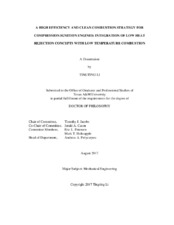| dc.description.abstract | Reciprocating engines are pervasively used in the transportation industry. The transportation industry is centered on achieving two important but often conflicting goals: 1) improved energy efficiency and 2) decreased pollution. Advanced engine technology seeks to accomplish these two goals, but there are technical barriers to implementation. For example, implementing an advanced combustion technology known as low temperature combustion (LTC) results in substantially decreased oxides of nitrogen and particulate matter emissions, but increased unburned hydrocarbons and carbon monoxide emissions that can also decrease engine efficiency. This study proposed a technology aiming to develop a solution to achieve improved energy conversion efficiency and lower emissions of internal combustion engines.
The basic idea is to integrate low heat rejection (LHR) concepts with low temperature combustion engine. A comprehensive analysis of engine performance and fuel consumption was conducted to study low heat rejection concepts in the light-duty diesel engine under both conventional and low temperature combustion modes. From most previous studies on LHR diesel engines, thermal-barrier coatings (TBCs) have been recognized as a conventional way to insulate engine parts. The LHR concept proposed in this study, however, is realized by altering engine coolant temperature (ECT). In previous experiments, the studied engine was overcooled to low ECTs and then increased to 100˚C in an effort to get trend-wise behavior without exceeding safe ECTs. This study uses a 1-D engine simulation of the conventional multi-cylinder, four-stroke, 1.9-L diesel engine operating at 1500 rpm to examine the engine performance and emissions at different ECTs. From the comparative study between conventional-LHR and LTC-LHR modes, it is found that implementing LHR yields more significant improvements in fuel conversion efficiency with LTC mode than it does for the conventional mode, pointing to a higher sensitivity to variations in ECT. The potential reasons causing the difference in engine performance are addressed mainly by comparing the effects of ECT on the combustion phasing between two modes. The results indicate that the integration of LHR with LTC leads the phasing of combustion toward favorable changes, which partly contributes to the significantly improved efficiency. | en |


